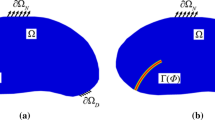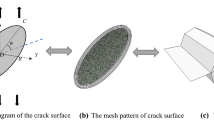Abstract
Compression-induced shear-mode cracks play an important role in the failure process of rocks. To gain insight into the compression-induced shear-mode cracks in rocks, the initiation and propagation of compression-induced shear-mode cracks are investigated via physical experiments and numerical simulations. The experimental results show that compression-induced shear-mode cracks are a common fracture mode and often lead to final failure. The initiation and propagation of compression-induced shear-mode cracks, as well as the strength of the specimen, can be influenced by the spacing between the flaw tips. Compression-induced shear-mode cracks easily initiate and propagate when the spacing between the two pre-existing flaws is small, whereas a larger spacing can reduce the possibility of shear fracturing and is propitious to the generation of compression-induced tensile-mode cracks. In addition, compression-induced shear-mode cracks initiate and generate later than compression-induced tensile-mode cracks. Furthermore, the fracture angles of compression-induced shear-mode cracks are diverse and complex and can be influenced by the spacing between pre-existing flaws. Numerical simulation results suggest that compressive-shear failure initiates randomly in a shear stress field, becomes more localized with the increased loading and eventually results in compression-induced shear-mode cracks.
















Similar content being viewed by others
References
Ashby MF, Hallam SD (1986) The failure of brittle solids containing small cracks under compressive stress states. Acta Metall 34(3):497–510
Bobet A (2000) The initiation of secondary cracks in compression. Eng Fract Mech 66(2):187–219
Bobet A, Einstein HH (1998) Fracture coalescence in rock-like materials under uniaxial and biaxial compression. Int J Rock Mech Min Sci 35(7):863–888
Brace WF, Bombolakis EG (1963) A note on brittle crack growth in compression. J Geophys Res 68(12):3709–3713
Chang X, Deng Y, Li Z, Wang S, Tang C (2018) Crack propagation from a filled flaw in rocks considering the infill influences. J Appl Geophys 152:137–149
Horii H, Nemat-Nasser S (1985) Compression-induced microcrack growth in brittle solids: axial splitting and shear failure. J Geophys Res Solid Earth 90(B4):3105–3125
Lajtai EZ (1969) Shear strength of weakness planes in rock. Int J Rock Mech Min Sci 6(5):499–515
Lan H, Martin CD, Hu B (2010) Effect of heterogeneity of brittle rock on micromechanical extensile behavior during compression loading. J Geophys Res-Atmos 115(B1):414–431
Levy S, Molinari JF (2010) Dynamic fragmentation of ceramics, signature of defects and scaling of fragment sizes. Journal of the Mechanics and Physics of Solids 58(1):12–26
Li SY, He TM, Yin XC (2010) Introduction of rock fracture mechanics. Press of University of Science and Technology of China, Hefei, p 138
Ma C, Li T, Zhang H, Jiang Y, Song T (2019) A method for numerical simulation based on microseismic information and the interpretation of hard rock fracture. J Appl Geophys 164:214–224
Melin S (1986) When does a crack grow under mode II conditions? Int J Fract 30(2):103–114
Morgan SP, Johnson CA, Einstein HH (2013) Cracking processes in Barre granite: fracture process zones and crack coalescence. Int J Fract 180(2):177–204
Mughieda O, Alzo’ubi AK (2004) Fracture mechanisms of offset rock joints—a laboratory investigation. Geotech Geol Eng 22(4):545–562
Nemat-Nasser S, Horii H (1982) Compression - induced nonplanar crack extensile with application to splitting, exfoliation, and rockburst. J Geophys Res Solid Earth 87(B8):6805–6821
Petit JP, Barquins M (1988) Can natural faults propagate under mode II condition? Tectonics 7(6):1243–1256
Ran JQ, Passaris EKS, Mottahed P (1994) Shear sliding failure of the jointed roof in laminated rock mass. Rock Mech Rock Eng 27(4):235–251
Rao Q, Sun Z, Stephansson O, Li C, Stillborg B (2003) Shear fracture (mode II) of brittle rock. Int J Rock Mech Min Sci 40(3):355–375
Reches Z, Locker DA (1994) Nucleation and growth of faults in brittle rocks. J Geophys Res-Atmos 99(B9):18159–18173
Scholz CH (2002) The mechanics of earthquakes and faulting, Cambridge University Press, Cambridge, UK, Chapter 1 & 3
Shen B (1995) The mechanism of fracture coalescence in compression—experimental study and numerical simulation. Eng Fract Mech 51(1):73–85
Shen B, Stephansson O, Einstein HH, Ghahreman B (1995) Coalescence of fracture under shear stresses in experiments. J Geophys Res 100(B4):5975–5990
Tang CA, Kou SQ (1998) Crack propagation and coalescence in brittle materials under compression. Eng Fract Mech 61(61):311–324
Tapponnier P, Brace WF (1976) Development of stress-induced microcracks in Westerly granite. Int J Rock Mech Min Sci Geomech Abstr 13(4):103–112
Vekinis G, Ashby MF, Beaumont PWR (1993) Gypsum of Paris as a model material for brittle porous solids. J Mater Sci 28(12):3221–3227
Wang TT (2010) Characterizing crack patterns on tunnel linings associated with shear deformation induced by instability of neighboring slopes. Eng Geol 115(1–2):80–95
Warner DH, Mathaudhu SN (2011) Influence of microcracking on shear localization. J Eng Mech 137(10):691–698
Wong LNY, Einstein HH (2009) Crack coalescence in molded gypsum and Carrara marble: part 1. Macroscopic observations and interpretation. Rock Mech Rock Eng 42(3):475–511
Xu J (2018). Study on fracture process and criterion of rocks induced by non-penetrating flaw. (Doctor Thesis) Southeast University, Nanjing, China
Xu J, Li Z (2019) Crack propagation and coalescence of step-path failure in rocks. Rock Mech Rock Eng 52(4):965–979
Yang SQ (2011) Crack coalescence behavior of brittle sandstone samples containing two coplanar fissures in the process of deformation failure. Eng Fract Mech 78(17):3059–3081
Zhang X, Liu Q, Wu S, Tang X (2015) Crack coalescence between two non-parallel flaws in rock-like material under uniaxial compression. Eng Geol 199:74–90
Zhao Y, Liang H, Huang J, Geng D, Wang R (1995) Development of subcracks between en echelon fracture in rock plates. Pure Appl Geophys 145(3–4):759–773
Zhao C, Niu J, Zhao Q, Zhao C, Zhou Y (2019) Failure characteristics of rock-like materials with single flaws under uniaxial compression. Bull Eng Geol Environ 78(1):593–603
Acknowledgements
The work described in this paper was substantially supported by the National Natural Science Foundation of China (Nos. 51974186, 51774164, 51774048, 41702381), and all these sources of support are gratefully acknowledged.
Author information
Authors and Affiliations
Corresponding authors
Rights and permissions
About this article
Cite this article
Xu, J., Xiao, X., Lv, X. et al. Simulation of compression-induced shear-mode cracks in rocks based on experimental investigations performed on gypsum specimens. Bull Eng Geol Environ 79, 4309–4319 (2020). https://doi.org/10.1007/s10064-020-01832-9
Received:
Accepted:
Published:
Issue Date:
DOI: https://doi.org/10.1007/s10064-020-01832-9




